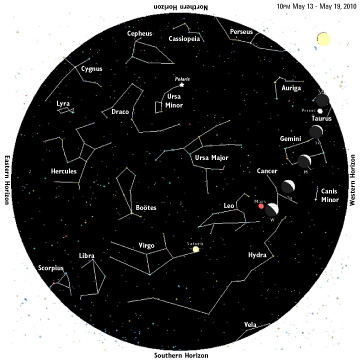Chesapeake Bay's Independent Newspaper ~ Since 1993
1629 Forest Drive, Annapolis, MD 21403 ~ 410-626-9888
Volume xviii, Issue 19 ~ May 13 to May 19, 2010
Home \\ Correspondence \\ from the Editor \\ Submit a Letter \\ Classifieds \\ Contact Us
Best of the Bay \\ Dining Guide \\ Home & Garden Guide \\ Archives \\ Distribution \\ Advertising![]()


Sky Watch

by J. Alex Knoll
Our Celestial Buzz-Bomb
Circling earth at more than 17,000 miles an hour, the International Space Station is a fleeting target
Sharp eyes and a clear view of the west horizon will reveal an ever-so-thin crescent moon emerging from the sun’s glare Friday just after sunset at 8:11. But you’ll also need good timing, as this nascent moon, just a day from new, dips beneath the horizon within 30 minutes of the sun.
Sunset the next night is a minute later, and it reveals the moon 15 degrees higher. Above and to the left shines dazzling Venus. Sunday, the moon and Venus are still only six degrees apart, but the noticeably fuller moon is now the higher of the two.
By Monday the waxing crescent is high in the west at sunset, shining beneath the twin stars of Gemini. Named after the Greek half-brothers Castor and Pollux, these two appear closer together than any other first-magnitude stars. Even so, like their namesakes, they are far from identical, with Pollux, the brighter of the two, shining golden, while Castor shines bluish-white.
By Wednesday the moon has nearly filled to first-quarter phase and now shines just a few degrees below Mars. While the ruddy planet climbs some three degrees higher week by week, it is no brighter than your average star, standing out more from its steady glow than as a result of its brightness.
Circling some 200 miles overhead at more than 17,000 miles an hour, the International Space Station streaks by so quickly you could easily confuse it for a passing airplane. It pops into view Friday at 9:11pm 28 degrees above the north-northwest horizon and arcs to the east-southeast before disappearing three minutes later. Saturday the ISS appears 28 degrees above the west horizon at 9:36, heading due south for all of two minutes. Monday the station appears 34 degrees high in the west at 8:50, streaking toward the south-southeast before disappearing at 8:53.
Illustration: © Copyright 1925 M.C. Escher/Cordon Art-Baarn-Holland; Graphics: © Copyright 2010 Pacific Publishers. Reprinted by permission from the Tidelog graphic almanac. Bound copies of the annual Tidelog for Chesapeake Bay are $14.95 ppd. from Pacific Publishers, Box 480, Bolinas, CA 94924. Phone 415-868-2909. Weather affects tides. This information is believed to be reliable but no guarantee of accuracy is made by Bay Weekly or Pacific Publishers. The actual layout of Tidelog differs from that used in Bay Weekly. Tidelog graphics are repositioned to reflect Bay Weekly’s distribution cycle.Tides are based on National Oceanic and Atmospheric Administration and are positioned to coincide with high and low tides of Tidelog.
© COPYRIGHT 2010 by New Bay Enterprises, Inc. All rights reserved.
